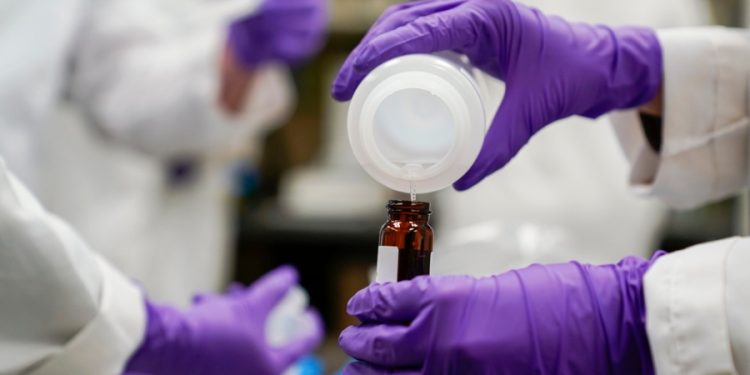A new study finding “forever chemicals” in nearly half of U.S. drinking water adds to a growing body of research on the toxic substances’ pervasiveness in American life.
Yet many Americans remain oblivious to the very existence of a cancer-linked group of compounds known as PFAS — or per- and polyfluoroalkyl substances.
Research published by the U.S. Geological Services (USGS) last week estimates that 45 percent of U.S. taps contain at least one type of PFAS or forever chemical.
This comes on top of other evidence that the chemicals are widespread, including research finding them in the blood of about 97 percent of Americans, as well as significant portions of U.S. waterways.
Toxicologist Jamie DeWitt told The Hill that she is hardly shocked by the findings, which she described as a “verification” from a government agency “that PFAS are present in multiple drinking water supplies as well as in finished drinking water.”
“Where scientists look for PFAS, they find them,” said DeWitt, a professor of pharmacology and toxicology at East Carolina University. “If they can find them in polar bears and in the bottom of the ocean, then we shouldn’t be surprised that we find them across drinking water supplies.”
DeWitt expressed dismay as to what she feels is an ongoing lack of public awareness about the very existence, let alone pervasiveness, of forever chemicals, even as an accumulating body of evidence piles up about their dangers.
She recalled speaking to an undergraduate student from Fayetteville, N.C. — home to a major PFAS manufacturer, Chemours — who had never heard of PFAS despite wanting to become a toxicologist.
“Maybe we’re not reaching the right audiences who really need to hear about PFAS, but I think that’s not uncommon with many different types of environmental pollutants, unfortunately,” she said.
Also problematic in the current political environment is the “mistrust of science right now,” according to DeWitt. “That’s another hurdle to overcome in terms of public health protection from contaminants,” she added.
Linda Birnbaum, former director of the National Institute of Environmental Health and the National Toxicology Program, echoed DeWitt’s sentiments with regards to the public’s insufficient knowledge of a growing PFAS problem.
“I wish the public understood and were concerned, but lots of people are still unaware,” Birnbaum said.
Exposure to PFAS — which are present in certain firefighting foams, Teflon pans, waterproof apparel and cosmetics — has been linked to illnesses such as kidney and testicular cancer, thyroid disease and high cholesterol.
While there are thousands of types of PFAS, the Geological Services study only looked for 32 types. Seventeen kinds of PFAS were observed at least once, while PFBS, PFHxS and PFOA were observed most often — in about 15 percent of the samples, according to the study.
Scott Bartell, a professor of environmental and occupational health at the University of California, Irvine, said that people who have the chemicals in their water should be concerned about elevated risks of cancer and other illnesses.
“We have good evidence that, for example, exposure to PFOA, which is one of the chemicals that was detected in many of the water supplies in the study, that it almost certainly causes kidney cancer,” he said.
Carmen Messerlian, an assistant professor of environmental reproductive, perinatal and pediatric epidemiology at Harvard, said that it’s not one specific chemical that is the problem, it’s the PFAS family.
“We know that the class of chemicals is carcinogenic, immunotoxic, reprotoxic, endocrine-disrupting,” she said.
Messerlian added that the fact that the study only looks at 32 chemicals rather than the thousands that are out there means it is very likely an undercount.
“If we’re only looking at PFOA and PFOS, for example, those are just two … types of PFAS. There’s thousands of them,” she said. “You can’t find something that you’re not looking for.”
Similarly, while the study’s authors — who sampled 716 spots nationwide — found that urban areas are more at risk than rural ones when it comes to PFAS, they also warned of “a notable paucity of data available for private-wells across the U.S.,” where information is often “limited or not available.”
“It highlights an area of our population that really aren’t going to receive the same types of protections that people like me receive,” said DeWitt.
“I get my water from a utility that serves a big population,” she added.
Utilities, DeWitt explained, will be required to adhere to the guidelines of the Safe Water Drinking Act as soon as the Environmental Protection Agency regulates maximum contaminant levels for the two most notorious PFAS variations, PFOA and PFOS.
But private well owners “aren’t going to be subject to the same set of rules,” according to DeWitt.
“So if you’re a well owner in a rural area, or if you get your water from a well in a rural area, you’re on your own,” DeWitt said, identifying what she described as “a huge gap.”
Many people who rely on private wells are also located in rural or underserved areas — and therefore already face numerous challenges, DeWitt explained.
“And yet again, they’re kind of left out in the cold,” she said.
The USGS findings were based on the 716 samples collected around the country and then extrapolated through a model.
The chemicals were found in about 70 percent of areas that are either urban or have a known history of PFAS contamination, compared to just 8 percent of rural areas. Areas with the greatest concentrations were in the Great Plains, the Great Lakes, the Eastern Seaboard and Central and Southern California.
“Some of the concentrations are probably due to population densities and where there are activities where PFAS are either manufactured or used,” DeWitt said.
It is also logical to find higher levels of PFAS near airports, municipal firehouses, military bases or places where the compounds are entering a wastewater stream, according to DeWitt.
“So I’m not surprised that it kind of tracks with where there are greater populations,” she added.
As far as public health ramifications are concerned, DeWitt was hesitant to draw a definitive conclusion as to whether the entire country is at risk based on the study’s conclusions.
But at the same time, she stressed that the world’s leading cause of chronic disease-related premature deaths is environmental pollution, citing findings from a 2017 Lancet study.
“If pollutants are the world’s leading cause of chronic disease, and PFAS are part of the mix of pollutants to which we are exposed, a logical conclusion would be that PFAS are contributing to chronic diseases,” DeWitt said.
“So in terms of public health, they’re undoubtedly part of the problem that leads to chronic diseases that we all will likely experience or that our loved ones will experience within our lifetime,” she added.
Erin Bell, a professor of epidemiology and environmental health sciences at the State University of New York at Albany, pointed to guidelines from the National Academies of Science, Engineering and Medicine, which recommend that doctors screen patients for different illnesses depending on the level of PFAS in their blood.
She also noted that PFAS is even being observed in the blood of newborn babies, referencing a study she conducted on infants born in New York state between 2008 and 2010.
“We detected measurable amounts in 99 percent of those infants,” she said.















